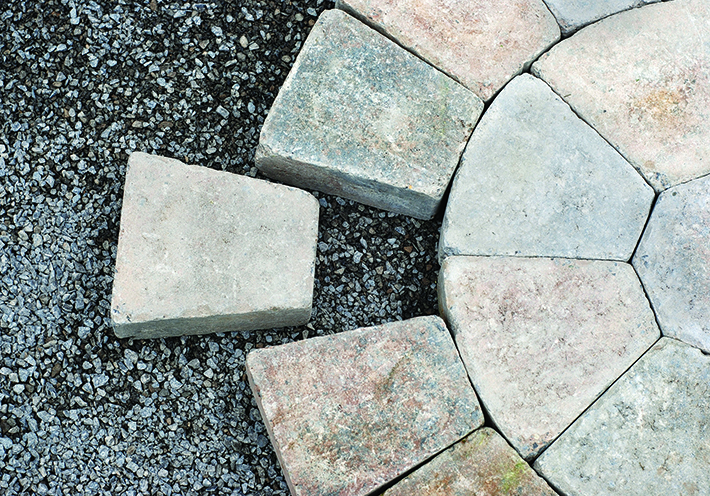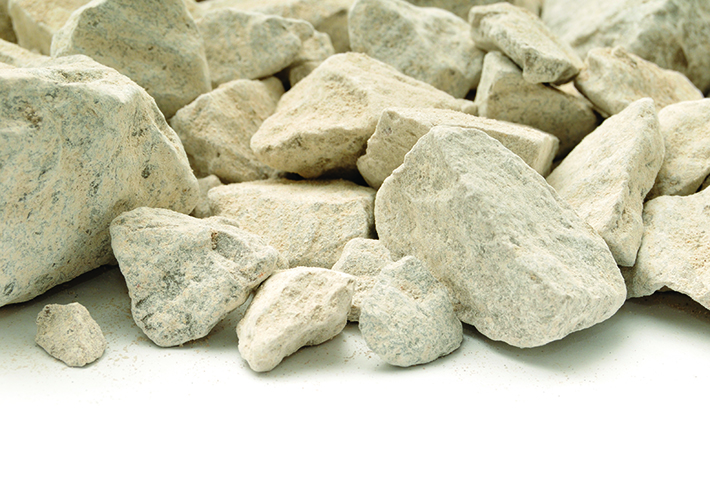
Stone Cold: Dimension Stone Standards
For as long as humans have erected homes and other structures, stone has served as a principal building material. Ancient builders quickly realized that sturdy, weather-resistant, easily stacked stones were essential not only to creating but also maintaining their temples, homes, bridges, and more. Modern contractors and craftspeople also appreciate the strength, durability, and longevity of these quarried rocks, and today refer to them as dimension stone.
Defined by the U.S. Geological Survey as “natural rock material quarried for the purpose of obtaining blocks or slabs that meet specifications as to size (width, length, and thickness) and shape,” dimension stone consists of a variety of igneous, metamorphic, and sedimentary rocks.
The most common are granite, marble, slate, sandstone, and limestone. Used in buildings, monuments, memorials, and paving, dimension stone does not include molded, aggregate, crushed, or powdered natural stone.
FOR YOU: Gloss and Grout: Standards for Ceramic Tile
During the period from 2550 to 2490 BC, ancient Egyptians extracted and sized limestone and granite for the Giza pyramid complex. To build the Parthenon from 447 to 432 BC, ancient Greeks quarried marble outside of Athens, transported it to the Acropolis by wagons, and trimmed the marble by hand until each block matched the others in size and shape. Later, the Mayan people employed hand-cut limestone to erect such pre-Columbian cities as Guatemala’s Tikal and Mexico’s Chichen Itza, while during the Middle Ages, Europeans fashioned sheets of slate into floor and roof tiles for castles, abbeys, and military buildings. By the 19th century, roofs clad in Welsh slate had become commonplace throughout the U.K. This roofing style would catch on in the United States and Australia by the early 20th century.
Early Test Methods
Although natural stones have not changed, people have changed the way they work with these materials. To ensure that dimension stone is correctly selected, attached, and maintained, ASTM International created the committee on dimension stone (C18) in 1926. Today, it has over 100 members, five technical subcommittees, and 28 standards for naturally occurring stone that is quarried, cut, finished, and used either as units or dimension blocks.
“When the committee was first formed, its focus was on developing test methods. By 1950, the test methods subcommittee [C18.01] had published eight of the 13 dimension stone test method standards presently in existence,” says David West, technical director at Inhabit and a member of C18 for over 35 years. “The standards covered direct physical properties, strength properties, and abrasion resistance, and included dedicated tests for slate, which was a very important material in those years.”
Committee chair and ASTM fellow Kurt Hoigard adds, “Roofing slate is a historic material predating our committee but even so, the committee wrote standards for roofing slate and how to test for it. Back in the day, slate was used for blackboards and every school had them. Because it’s very durable, it was also found in windowsills, floor tile, and pool-table beds. To this day, a good pool table will have a slate bed in it. It’s a unique material in that it’s strong even when it’s very thin.”
Slate testing standards include the standard test method for water absorption of slate (C121) and standard test methods for weather resistance of slate (C217). The latter looks at the performance and anticipated lifespan of different types of slate utilized in roofing. A third standard, test methods for flexure testing of structural and roofing slate (C120), helps to determine the differences in the breaking load of roofing slate and the modulus of rupture of structural slate.
The standard test method for modulus of rupture of dimension stone (C99) is another significant standard from the subcommittee and helps determine the modulus of rupture of all types of dimension stone except slate.
The committee continues to draft test methods and currently has several work items, including new test methods for effect of rapid freezing and thawing on mechanical properties of natural stone (WK84902) and new test methods for resistance of natural stone to rapid freezing and thawing (WK81245). These complementary standards employ rapid freezing and thawing in either fresh water or salt water to test the impact of freeze/thaw cycles on stones’ competence, mechanical properties, and aesthetics.
Guiding the Use of Dimension Stone
According to the 2023 Dimension Stone Global Market Report, construction and real estate demands are expected to boost the global dimension stone market by roughly 7 percent, allowing it to reach $9.12 billion in 2023. The list of major consumers and producers includes Australia, Brazil, China, France, Germany, India, Indonesia, Iran, Italy, Japan, Russia, South Korea, the U.K., and the U.S. Of these countries, in 2020, China produced 32.4 percent, India 17.2 percent, Turkey 7.6 percent, and Brazil and Iran each quarried 5.3 percent of the world’s dimension stone. In that same year, the United States imported roughly $1.8 billion of dimension stone.
With the interest in dimension stone predicted to steadily increase, so will the need for specifying and guiding its employment. Assisting with this requisite is the standard specification for granite dimension stone (C615). Developed by the subcommittee on material specifications (C18.03), this standard presents the material characteristics, physical requirements, and sampling method for selecting granite dimension stone for building and structural purposes. The functions of dimension stone include the exterior and interior cladding of buildings and structures; curbstone, paving, and landscape features; grade separations and retaining walls; and monuments. The physical property requirements of granite dimension stone include absorption by weight, density, compressive weight, modulus of rupture, abrasion resistance, and flexural strength.

Standards for dimension stone help build and maintain the structures all around us.
The dimension stone committee has likewise published several key guides, such as the standard guide for selection, design, and installation of dimension stone attachment systems (C1242).
Created by the subcommittee on attachment components and systems (C18.06), it is the first guide released by the group. It details the anchoring of dimension stone directly to a building structure or to subframes or curtain-wall components that are then attached to a structure. Additionally, the guide establishes the basic requirements for the design of stone anchorage and the categories of anchors and anchoring systems.
“The chair of C18.06, Mike Lewis, picked up the development of this standard and has made it his mission to keep improving and expanding it over the last 20 years,” Hoigard says.
Hoigard, who is a professional engineer, explains that traditionally, dimension stone was attached with metal connections that engaged both the stone and whatever was behind it. “Ten to 15 years ago, people started literally gluing stone onto buildings with no guidance. The subcommittee dove in and started providing guidance on how to best adhere stone to homes and commercial structures. Thinly cut stone can also be adhered to an aluminum honeycomb substructure and then the assembly is attached as you might have originally attached solid stone panels.”
West believes that, at the moment, C1242 is the most important dimension stone standard published by C18. “Because it is a guide, it gives a lot of valuable information and guidance to designers who want to put stone on building facades,” he says.
The Right Stone for the Job
To ensure the proper stone is chosen for its intended function, the subcommittee on selection of exterior dimension stone (C18.08) released the standard guide for selection of dimension stone (C1528). “In the stone industry, we say, ‘There’s no such thing as a bad stone. There’s only improper selection and application of a stone,’” Chuck Muehlbauer says. He is a former chair and 33-year member of C18 as well as the technical director of the Natural Stone Institute. “People simply pick the wrong stone and use it in an environment where it cannot survive.”
FOR YOU: A Mosaic of Leadership: Q&A with 2024 Board Chair Bill Griese
The subcommittee also has a guide out for ballot: The new guide for the selection, design, and installation of exterior dimension stone paving systems (WK86868). The guide will aid architects, engineers, designers, contractors, and material suppliers who design, fabricate, finish, select, purchase, or install stone for exterior paving applications such as sidewalks and public areas.
Muehlbauer notes that many of the subcommittee members are forensic architecture engineers who regularly investigate construction issues and failures. These members pointed to a disproportionate number of failures in stone pavers subjected to vehicular traffic as a factor that necessitated the guide.
“In many cases, the designs were not adequate for the loads imposed on the dimension stone, so there was a need for this guide to help people design these systems,” Muehlbauer says. “We do have structural issues in some pavement systems because it is fairly common to set stone pavers on pedestals. With pedestals, the stone is only supported at its four corners – there is actually nothing beneath it. In this circumstance, the stone does become a structural element and, yes, we’ve seen failures with those.”
He adds, “I have a picture of a delivery van that went through the sidewalk, simply because no one expected that sidewalk would have to support a van.”
Global Use and Challenges
As a result of stone’s universal appeal as a building material, ASTM’s dimension stone standards likewise have global adherents. From the 1980s through the last decade, they have been the primary standards for Australia, much of Asia, and the Middle East.
“In Australia in the 1980s, we developed a test lab specializing in stone testing that promoted the ASTM standards as the benchmark,” West says. “That lab really created the environment where ASTM standards became the norm. If you’re specifying stone in Australia, ASTM standards are generally the go-to source and reference point. We are starting to see some interest, though, in the European standards, although this may change again in the future as ISO [International Organization for Standardization] now has a committee on dimension stone standards.”
Possessing reliable standards with long, venerated histories is a major accomplishment. Yet, the very longevity of C18’s dimension stone standards also presents a curious challenge.
“The test method standards have provided a consistency in data for the industry for a very long time, but the consistency is challenged simply because the standards have been around for so long,” says West. “That’s one of the interesting tensions in the standardization process: having longstanding test method standards that are essentially unchanged in their core principles and have served the industry well. But then having this pressure to change them. ‘If they’ve been around that long, don’t they need to be updated? Don’t they need to be improved to reflect the way we currently do things?’ There’s a risk that you change the benchmark without realizing you’re changing the benchmark. At the end of the day, they’re standards and we want them to bring that degree of consistency.”
The committee on dimension stone convenes each year in April and October and ends its two days of technical meetings with a tour of a quarry and stone fabrication mill. For further information or to join C18, please contact staff manager David Lee at dlee@astm.org. ■
Kathy Hunt is a U.S. East Coast-based journalist and author.
 SN Home
SN Home Archive
Archive Advertisers
Advertisers Masthead
Masthead RateCard
RateCard Subscribe
Subscribe Email Editor
Email Editor